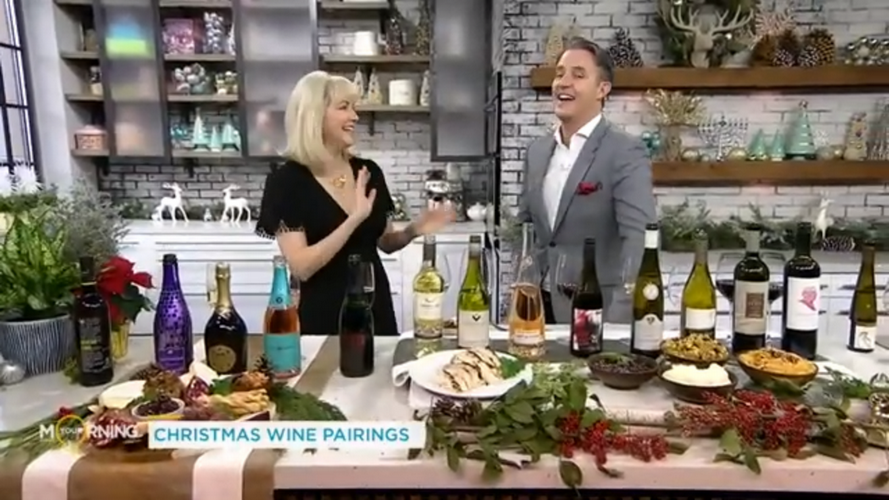CTV’s Your Morning Host Ben Mulroney and chat about which wines to pair with your holiday turkey dinner, from appetizers and the big bird to side dishes and dessert.
Happy holidays!
Natalie
Start with an aperitif
As the heady aroma of the turkey wafts through the house, and sounds of Miracle on 34th Street come from the livingroom, offer family and friends an aperitif. This pre-dinner drink will whet their appetites before they sit down to the table.
An excellent choice is a chilled dry sherry. Its nutty flavours go well with spiced nuts, olives, cheese and other pre-dinner nibbles. Sherry also makes a good segue into the meal if you’re starting with soup and have added a splash of it into the potage. Sparkling wine, is another good choice for an aperitif: it adds a celebratory note to the meal and goes well with both soup and salad starters.
Santa Margherita Brut Valdobbiadene Prosecco Superiore
Veneto D.O.C.G., Italy
Henry of Pelham Cuvée Catharine Estate Blancs de Blanc
Short Hills Bench, Niagara Peninsula, Ontario V.Q.A., Canada
Alvear Sherry
Montilla-Moriles D.O., Spain
Taittinger Nocturne Champagne
Champagne A.C., France
Consider the turkey
Turkey differs from most poultry and game birds in that it’s very dry in texture. Therefore, you need a juicy, mouth-watering wine with lots of ripe fruit to complement it. This is why pinot noir, with its aromas of ripe strawberries, raspberries and cherries, is the classic match. Those from the New World, such as Canada, California, Oregon and New Zealand, tend to be fruitier than those from the Old World, such as Burgundy and Germany, which tend to be earthier.
But both styles will suit the bird just fine. Beaujolais and gamay also work because they too have that medium-bodied, ripe berry flavour. These wines also offer the advantage of appealing to a wide range of palates. If you want something a bit more full-bodied, with a bit of spice, try a California zinfandel. However, reds with big tannins, such as cabernet sauvignon, often taste too dry with turkey. Similarly, the nuances of complex and well-aged wines, such as bordeaux, tend to get lost under the welter of flavours.
Villa Maria Estate Private Bin Sauvignon Blanc
Marlborough, New Zealand
Trapiche Reserve Pinot Grigio
Mendoza, Argentina
Adamo Estate Winery Lowrey Vineyard Pinot Noir
St David’s Bench, Ontario V.Q.A., Canada
Gérard Bertrand Côte des Roses Rosé
Languedoc, Midi A.P., France

Side Dishes
Look beyond the bird. Thanksgiving dinner is much more than turkey: it can include chestnut stuffing, cranberry sauce, spicy sage and thyme stuffing, oyster dressing, chestnuts, buttery mashed potatoes, creamed onions, candied sweet potatoes, squash, giblet gravy, succotash (creamed sweetcorn, beans and onions) and a host of traditional family recipes.
For some of us, the turkey is simply an excuse to eat more cranberry sauce. So when choosing a wine, you don’t have to simply match it to the turkey, particularly if you’re a fan of more full-bodied reds and whites. Since it’s often a sit-down, banquet-style meal where each person chooses the trimmings, why not do the same with the wines?
Offer both a red and white wine, depending on the size of your group. Count on one bottle of wine for every two people drinking wine at the table.
Ghost Pines Chardonnay
Napa, Sonoma, Monterey, California, United States
Reif Estate Winery Riesling
Niagara-on-the-Lake, Ontario V.Q.A., Canada
Complement or Contrast
If you prefer to serve the wines one at a time, move from light to full-bodied, simple to complex, white to red, young to mature and dry to sweet so that each wine tastes bolder than the last. There are two routes to go when choosing the specific wines you will offer: complement or contrast. For instance, you can complement the roasted, smoky flavours of the squash, apples and pecan stuffing with a big, buttery chardonnay from California or Chile. However, if you’d rather cut through the richness of the cream sauces and dressings, try something crisp, such as a New Zealand sauvignon blanc or German riesling.
La Celia Elite Malbec
Paraje Altamira, Uco Valley, Mendoza, Argentina
Peter Lehmann Wines Eight Songs Shiraz
Barossa Valley, Australia
Dessert Wines
Offer a sweet ending When dessert arrives, offer an Ontario icewine or late harvest wine with pumpkin pie or crème brulee. If you’re a chocolate fan, try a liqueur with complementary flavours such as raspberry or black currant. The wine you chose should be sweeter than the dessert so it doesn’t taste dull and bitter.
For children and guests who won’t be drinking, offer non-alcoholic beverages such as plain and flavoured sparkling waters, fruit punch and apple cider. With so many flavours on the table, you really can’t run afoul with your choice of wine.
Fonseca Porto White
Douro, Portugal
Cave Spring Indian Summer Select Late Harvest Riesling
Niagara Peninsula, Ontario V.Q.A., Canada
Henry of Pelham Winery Riesling Icewine
Niagara Escarpment, Ontario V.Q.A., Canada
Southbrook Vineyards Framboise
Niagara-on-the-Lake, Ontario, Canada
Posted with permission of CTV.






















